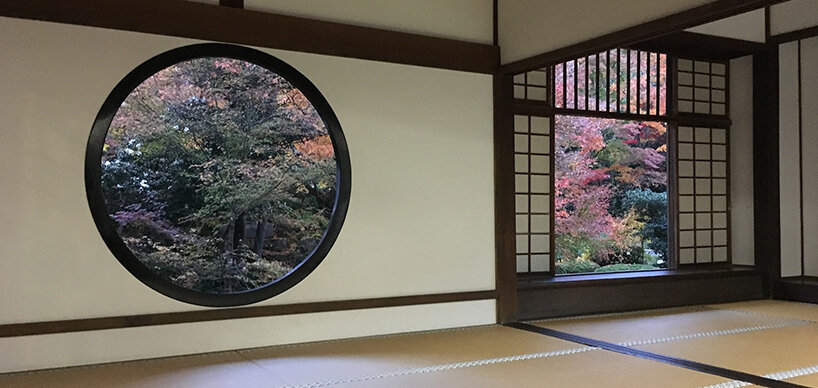Folding Screen, Room Divider, and Magnificent Simplicity

Discretion, please: The partition is an integral part of Japanese interior design. Foldable room dividers can be almost anything: from decoration to wardrobe to a political instrument. The relatively new concept of a door in Japan is revealed by the language: the Japanese word for it is "doa," a loanword from English ("Door"). What did the Japanese use as a door before their culture was influenced by international trends?
From movies, traditional Japanese homes, and Ryokan inns, one is familiar with the elegant sliding doors at the entrance. They are called Shoji and are made of special, sturdy, and lightly translucent paper (Washi). This reliably protects against cold, rain, and prying eyes. At the same time, it allows enough light to brighten the room. There are two variations of Shoji: the one-sided version displays delicate wooden frames on only one side facing the interior. Double-sided models are of higher quality, although one side is always slightly rougher and more fibrous than the other.
Not only used as an exterior barrier, but paper and wood are also commonly used indoors: as room dividers or folding screens. These originate from ancient times but have continually reinvented themselves, serving purposes far beyond mere decoration.
A view through the privacy screen

How the screen became foldable
Byobu, the Japanese word for the folding screen, literally means "wind wall," providing protection against wind or drafts. Like Shoji, these room dividers are made of wood and paper. However, silk, satin, and even more luxurious materials can be used – especially when the screens are adorned with paintings. These dividers are usually double-sided, allowing you to admire both the wooden pattern and intricate images from both sides. They consist of multiple elements or panels that can be folded together, making the display versatile and the room divider easy to store.
This foldable folding screen originally comes from China and Korea. They were likely developed there before our time and primarily used to shield against drafts. At the same time, the divider provided good privacy. Paravents arrived in Japan in the 7th century, initially consisting of a single element. It was only about a hundred years later that foldable room dividers, spanning multiple panels, were produced. Often, they comprised six elaborately painted elements adorned with silk brocade.
Initially, they found a place in temples, shrines, and princely residences before gradually making their way into shops, dojos, and homes. One of Japan's oldest examples is the six-panel folding screen from Toji Temple in Kyoto, built in 796. You can still admire this room divider there, featuring a depiction of bamboo against a mountainous background.
Due to the use of various materials like silk, leather, and wood, the folding screens were heavy and cumbersome. It wasn't until they were crafted with durable paper that they became easy to carry and set up. Additionally, the paper, replacing silk frames, allowed the entire depicted image to be seen seamlessly across multiple panels without interruption.
Room divider with cult status
In the 16th century, during the Momoyama era, peace and unity prevailed after a long period of war, and modern life began to unfold. Simultaneously, the Japanese developed a growing interest in art: Decorative folding screens became status symbols and sought-after collectibles. Sometimes, paper and wood were adorned with metals like gold leaf. Some Byobu painters are said to have even developed a lottery system to finance expensive materials such as silk, satin, and gold. The motto seemed to be the bigger, more magnificent, and more elaborate, the better.
How does this align with the aesthetic of humility deeply rooted in Japan? In the 17th century, consumption indeed flourished. Artists were supported by wealthy patrons, and exhibitions were organized. One such event is the Gion Festival in Kyoto, which still takes place every year in July. Parades and exhibitions showcase the best of Japan's traditional arts. Even private individuals can flaunt their family treasures there.
One thing is certain: Without the artists and their patrons, there would be no valuable folding screens. The intricately detailed panels of hand-painted dividers tell a unique story in ink. The art of folding screen painting is called Byobu-e and is still practiced today in family traditions. The choice of material for the folding screen, whether fine or coarse, must naturally complement the image itself, which can take on numerous forms.

Legends made of paper, silk and paint
Japanese folding screens often feature ornaments and motifs from nature: seasonal plants like cherry blossoms or maple leaves, bamboo forests, or animals such as dragons, tigers, and cranes. Each object and color carries a special significance. Folding screens were often given as dowry to noble brides, featuring subtle instructions on court etiquette. For weddings and newborns in high society, Shiro-e Byobu, adorned with symbols of luck such as the Chinese phoenix, are set up. They are named "white image" because the motifs are painted on white silk, symbolizing purity.
People and stories, on the other hand, emerged on folding screens only in the Middle Ages. Sometimes, scenes from historical daily life or Japanese mythology, poetry, and literature can be found. For example, the Tale of Genji, a novel from the 11th century about the Emperor's son Hikaru Genji and his romantic adventures, is highly popular among folding screen artists. Colorful illustrations on the screens depict the lavish life of the aristocracy at that time.
Calligraphy is also frequently featured on Japanese room dividers, with entire books sometimes transcribed onto the screens. Artists often inscribe traditional poems, known as Waka in Japanese. When these poems focus on longevity (Ga), the screens are called Ga no Byobu. Alongside depictions of birds and seasonal flowers, they are meant to bring a long life and celebrate it.
Originally, these screens were also diplomatic gifts. Their paintings conveyed a message, even if it was sometimes ironic: For example, screens with warrior motifs were sent to Korea, where Japan invaded several times in the following centuries.
The Japanese partition wall speaks its own language
To fully appreciate the artwork, it's essential to set up the folding screen correctly: in a zigzag pattern. A Byobu rarely stands alone, especially at official receptions. They are often arranged in pairs, with each having a different significance. The more important part is always on the right, where the motif begins.

Interesting is that there can only be an even number of panels; otherwise, the room divider would be asymmetrical – hence, four, six, and eight-panel screens are particularly common. Depending on the number of panels, the width varies: With the usual six elements, you get about 370 cm. There are also many variations in height: Between 50 and 200 cm, for example, everything is possible – depending on the sense and purpose of the partition. There are so many of them that different categories of screens result:
- The original screens with only one panel are called Tsuitate
- Two-part screens, Nikyoku, were particularly important for the tea ceremony, where they are called Furosaki. They are not very high, as they are only meant to symbolically separate the host from the guests
- For the waiting rooms of tea houses, four-part screens were set up, the so-called Yonkyoku
- The almost man-high Rokkyoku, screens with six panels, are the most popular today and decorate many homes and public spaces
- Today, there are even Japanese room dividers with ten elements (Jukyoku), which are particularly suitable for hotels and conference rooms
- For the wardrobe, there are Makura Byobu. These screens with four or six parts are particularly low and serve as a kind of clothes rack and separation for changing in the bedroom
- Especially interesting are the Koshi Byobu: In times of war in the 15th and 16th centuries, they served as protection for the guests of a house. If they stood behind the host, no one could hide behind them and threaten the guests
How the screen came to us
When visiting old palaces, temples, and shrines in Japan, you will sooner or later come across such a partition. Single-panel screens are still found in some shops and restaurants. Also, in Japanese theater, the screen is a must: it often stands as a backdrop on the stage. The Noh and Kabuki theater forms use the symbolic tree motifs on the screens for their performances.

The folding screen came to us thanks to Dutch, Portuguese, and Spanish merchants. That's why it is now called the "Spanish wall." It owes its French name to its popularity among the French nobility. Instead of paper, other materials such as fleece or wallpaper are often stretched onto the wooden frame, which is printed with colorful motifs. There are also wooden screens without other materials. Japanese screens were found in museums from the 19th century and inspired Western artists. For example, they can be discovered in paintings by the Impressionist Edouard Manet.
Today, you can get a machine-made screen online for a low double-digit price. Such a privacy screen can be white, brown, in rare cases black, or printed in many colors. However, for hand-painted vintage models with paintings, which are coveted by collectors, you can also spend thousands of euros. Caution is advised with such delicate specimens: to preserve them for a long time, they should be stored in a warm and humid environment, corresponding to the climate of their homeland, Japan. Undoubtedly contributing to their success with non-collectors is that the room dividers are easy to assemble, portable, and versatile. Folded up, they save space and do not fade or accumulate dust as quickly. They can even be personalized online and inexpensively according to your preferences: you can, for example, have them printed with a photo.
Whether indoors or outdoors, in the living room, kitchen, or garden: screens are excellent for beautifying, creating ambiance, and providing privacy. Not only in Japan can the room divider serve its purpose and tell ancient, fascinating stories.
Why not also read our article on Ikebana flower arranging art:











-from-the-yakiyaki-grill-pan.jpg)




